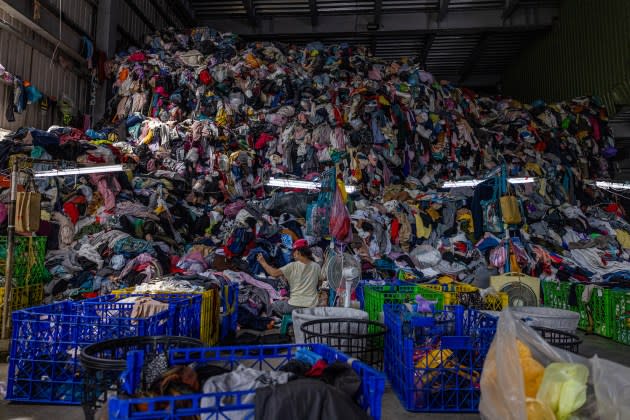Is Textile Recycling in the UK Really About to Collapse?

The UK’s Textile Recycling Association (TRA) is sounding the alarm.
The “imminent collapse” of the country’s textile recycling sector is reportedly nigh due to global market challenges like the crisis in the Red Sea and the rise of fast fashion.
More from Sourcing Journal
Escalated operational costs for textile merchants, disrupted shipping lines with increasing taxation from African and Asian markets and “mounting pressure” to curb waste exports are factors putting the industry under “immense” financial strain.
“Fast fashion has intensified the influx of low-quality textiles into the recycling stream,” the TRA said in a statement. “This has further driven up operational costs, pushing many textile merchants to the brink of financial collapse.”
As the recognized trade association for over 75 percent of the UK’s used textiles collectors and sorters, the organization has been “made aware of their plight,” the TRA said. “There is real fear in the industry about being unable to collect from charity shops, recycling centers and community textile banks due to reaching capacity at processing plants.”
If the UK can’t collect this waste, the wider impact could have “devastating environmental consequences,” considering 92 million tons of textile waste are produced each year. Not to mention, the livelihoods of industry workers are at risk. The used textiles industry in the UK is valued at over 1 billion pounds annually, the TRA said—impacting one in every 25 jobs in the country.
Furthermore, European countries potentially halting textile sorting operations compound the industry’s fears for the sector’s future, the TRA said. France, Denmark, Sweden, Finland and Austria have proposed a ban on the export of used textiles within the EU, signaling a “significant shift” in policy.
The TRA is “urging” UK government to step in and regulate the industry, including an introduction of an extended producer responsibility scheme, which is a policy approach that assigns producers responsibility—financially, operationally, or both—for the end-of-life of its products.
“UK textile policy is non-existent and is indicative of the current [government] which have done nothing to address the environmental fall out of inaction,” Jo-Anne Godden, a circular textiles developer, posted on LinkedIn. “Says something when industry is demanding regulation—and yes, we must stop exporting used textile waste as part of a wider EPR scheme to reduce quantity and promote textile quality—and use it to fuel a new circular economy.”
The TRA replied to Godden’s comment, stating she is “absolutely spot on.”
“The UK government does not see this sector as an essential service provider and has not supported it at all,” the association wrote. “EPR will certainly address the issue but if we are looking at it to be the savour [sic] we are very much mistaken. Collaboration is key to survival with transparency at its heart.”
Last August, The United Kingdom’s Department for Environment, Food & Rural Affairs (DEFRA) laid out a new roadmap for handling waste, including textiles, to be enacted over the next few years.
That roadmap, titled “Maximizing Resources, Minimizing Waste,” was dubbed one of the government’s biggest opportunities to move toward more circular and sustainable practices in England. And within the framework was the plan to “develop a textiles waste hierarchy to provide robust guidance to businesses managing textiles and fashion products and materials,” the policy paper reads.
The government planned to explore “putting the textiles hierarchy on a firm statutory footing” by considering several measures, including a requirement to “present reusable and recyclable textiles for separate collection and for the collecting organization to separately collect and store until treating in accordance with the waste hierarchy, by sorting for reuse and recycling,” DEFRA said.
Another potential was banning separately collected material from being sent to landfill without prior sorting—bringing into scope the destruction of products and materials that can be reused, redistributed and recycled.
The government department is also considered requiring businesses over a certain size to provide customer take-back systems for used textiles, exploring how to encourage online-only companies to partner with brick-and-mortars to “ensure the costs of implementing take back schemes are appropriate.”
As it stands today, it is unclear how many—if any—of these objectives were, in fact, explored.
DEFRA did not respond to Sourcing Journal’s request for comment.
